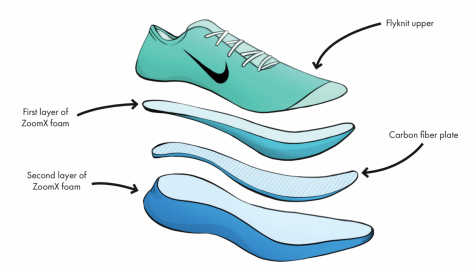Crossing the Line
Nike Vaporfly 4% energy return claims
Amid the dust being kicked up by the runners, John Tayeri, senior captain of the cross-country team, emerges over the crest of the hill, triumphant, wearing a pink head- band and neon orange running shoes, the Nike Vaporfly 4%.
When these $250 shoes were unveiled in 2017, they were released with a Nike-sponsored peer-reviewed journal article claiming that the shoes gave runners a 4% increase in running economy compared to an Adidas marathon shoe.
Wouter Hoogkamer, a postdoctoral researcher at University of Colorado, Boulder, and one of the researchers involved in the original Nike sponsored study, makes an important distinction on what exactly the 4% refers to.
The “4%” in the name refers to a reduced energetic cost of running, rather than a 4% increase in speed, according to Hoogkamer.
Researchers measured oxygen consumption while running, allowing them to calculate burned carbohydrates and fatty acids.
Using this information, they were able to calculate the amount of energy the runners were using when running in different shoes. The researchers concluded that the Nike Vaporflys reduced the runner’s energetic cost by 4% as compared to other shoes.
The “4%” claim has been verified by both an independent New York Times analysis and an independently funded study by Grand Valley State University, which also included women, unlike the original Nike funded study.
Notably, studies show that energy economy affects race speed proportionally, although they are not interchangeable.
After initial skepticism regarding the claim, attention in the running world shift- ed to how the shoes increased performance. According to the Nike website, the shoe boasts a “full-length carbon fiber plate [that] feels like it’s propelling you forward.”
Due to Nike’s marketing, most thought this carbon plate was thought to act some- what like a spring, skirting the line between a shoe and a propulsion device, and drawing calls to ban the shoe in competition.
A little more than a year after their mass-market release, Hoogkamer released a follow-up study examining the cause of the metabolic savings of the shoe.
There is not one specific technology the shoe uses to which the increase in economy is attributed. Differences in ankle movement, partially due to the carbon fiber plate, seem to partially contribute to the 4%, while the bouncier foam delivers slightly more energy return. Though neither carbon fiber plate nor the foam are individually responsible for the significant energy return.
“It’s not just one plus one is two,” Hoogkamer says. “They seem to work together very nicely where it’s more like one plus one might be three.”
Tayeri wore the shoes in two races this season and enjoyed the experience. However, because he works at Fleet Feet, a running store in Menlo Park, he bought the shoes at a discounted price.
“Usually, one of the trade offs of a cushion shoe is it’s much heavier, but [when wearing the Vaporfly 4%] I only felt like I was being sprung off the ground,” he says.
